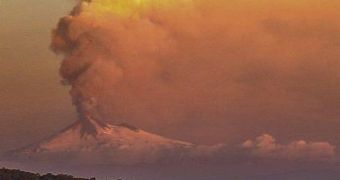The Llaima volcano, one of the most active in Chile and South America, erupted again on Friday night, prompting evacuation from areas all around it. Since its large eruption in 2008, the mountain continued to spill out lava and ash on occasions, but the most recent activity was at a large scale, so people had to flee their homes. Yesterday, the magma room threw ash and other materials more than 4 miles into the atmosphere, prompting renewed efforts on the part of the authorities and an extension of the to-be-evacuated area.
“The volcano continues to permanently erupt with explosions, lava flows and ash. More people were evacuated overnight because of the risk of mud avalanches as the lava melts snow on the volcano,” an official from the state National Emergency Office, Helia Vargas, told Reuters. She added that lava flowed on the sides of the volcano in three directions, and that each of the flows extended for several hundred meters. In such cases, if the molten rock hits the snow, it instantly transforms it into gas, but also into water, and can prompt mud floods, or even land slides.
Chile is located in the Pacific Ring of Fire, an imaginary circle comprising the western coasts of North and South America, as well as Japan and other places in Eastern Asia. It is the place where increased tectonic activities have prompted the appearance of a large number of volcanoes, which continuously threaten the human population in the area. The South American country has roughly 2,000 volcanoes on its territory, of which 50 to 60 are confirmed to have erupted, with some 500 more potentially active.
The Llaima is one of the most active, even though the danger it poses to humans is not extremely great per se. In other words, less than 11 people had to be evacuated from around it, as the area, famous worldwide for its beautiful lakes, does not house many individuals. The majority of the population is concentrated in small villages and other settlements and evacuating them is fairly easy, even though the region is not easily accessible.

 14 DAY TRIAL //
14 DAY TRIAL //